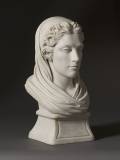Cincinnati Art Museum
Caroline Campbell, Lady Ailesbury
- Marble
- 21 × 11 inches · 533 × 279 mm
- Carved in 1789
Inscribed:
On the front of the socle: ‘CAROLINA •/ CAMPBELL •/ ARGATHELLAE •/ DUCIS • FILIA •’
On the left-hand side of the socle: ‘ANNA •/ SEYMOUR • DAMER •/ FECIT •’
On the back of the bust: ‘ANNA/ ΣΕΙΜΟΡΙΣ/ ΔΑΜΕΡ/ ΕΠΟΙΕΙ/ ΦΙΛΗ ΜΗΤΗΡ/ ΑΥΤΗΣ’
Engraved:
By John Jones, ‘Caroline Campbell Countess of Ailesbury, from the original bust in marble executed by her daughter the Honble Anne Damer’, stipple engraving, published by James Roberts, June 26, 1790.
Collections
- Bequeathed by the artist to her cousin Lady Louisa Johnston;
- Captain Frederick Campbell-Johnston (1812-1896), son of the above;
- By inheritance in the Campbell-Johnston family;
- Campbell-Johnson sale, Sotheby’s London, 8th December, 2006, lot.142;
- Private collection, New York to 2022;
- Lowell Libson & Jonny Yarker Ltd.
Exhibitions
- On loan to the British Galleries at The Metropolitan Museum of Art, New York;
- Strawberry Hill, Twickenham, 2021-2
Literature
- Percy Noble, Anne Seymour Damer: A Woman of Art and Fashion, London, 1908, p.79;
- Ed. W. S. Lewis, The Yale Edition of Horace Walpole’s Correspondence, New Haven and London, 1944, vol.12, p.274, ‘Her mother in marble’;
- Ingrid Roscoe, A Biographical Dictionary of Sculptors in Britain 1660-1851, New Haven and London, 2009, p.336, no.31;
- Richard Webb, Mrs D The Life of Anne Damer (1748-1828), Studley, 2008, p.XXIV, reproduced.







